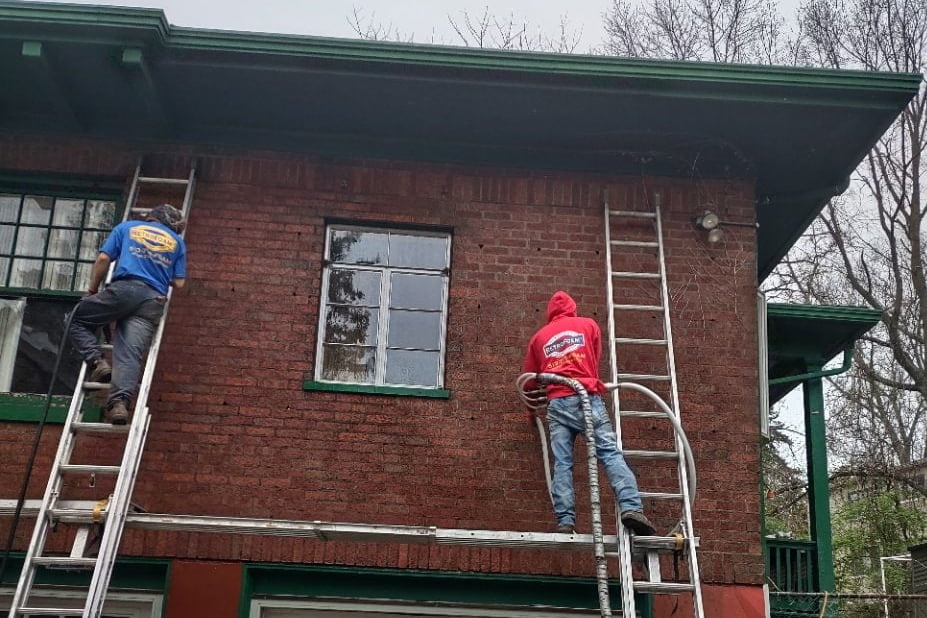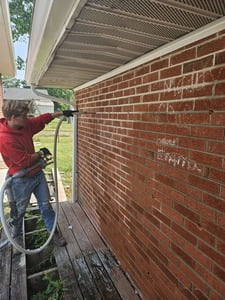Keeping your home properly insulated is key for comfort, efficiency, and cost savings. But when it comes to exterior brick walls, what are the best insulation options? Can spray foam be used on brick? Below, we’ll explore the purpose of insulation, compare types like spray foam and injection foam, and detail why injection foam is uniquely suited for brick exteriors.
The Basics of Home Insulation
Home insulation creates resistance to heat flow and is essential for energy efficiency. Heat naturally transfers from warmer to cooler spaces. In winter, insulation keeps heated indoor air inside. In summer, it keeps hot outdoor air from entering, allowing you to maintain comfortable temps with less energy usage.
The recommended insulation level is an R-value between R-13 and R-21 for exterior walls. Higher numbers indicate better insulation performance. Popular types of insulation include:
Spray Foam Insulation
Spray foam insulation uses polyurethane foam to create an air-tight barrier. As a liquid, it can fill the smallest gaps and expand to create a complete seal. Once cured, it acts as highly effective insulation with insulation values of R6 or more per inch. It’s also moisture-resistant.
Uses for spray foam insulation include sealing attics, rim joints, cluttered areas that are tough to insulate, and exposed spaces like basements and crawlspaces. Open and closed cell foams are available. Open cell is good for allowing moisture to escape while closed cell creates a moisture barrier.
Injection Foam Insulation
Injection foam insulation involves inserting foam via injection into cavities and voids inside walls. It fills the empty spaces in walls without expansion pressure. This allows insulation for finished interiors without removing drywall.
Unlike spray foam, injection foam does not stick to surfaces. It simply fills the space to create resistance to heat flow. This makes it easy to drill access holes in mortar lines on brick homes, inject foam between brick/stud wall cavities, and later patch the holes.
Blown-In Fiberglass Insulation
This involves blowing loose-fill fiberglass pieces using special equipment to distribute them between walls or attic spaces evenly. Blown-in fiberglass offers plenty of nooks and pockets to trap air and resist airflow.
It can reach areas difficult to install batt insulation. It isn’t the best option for walls, though, because it can settle over time. It’s perfect for attics, where it can easily cover the entire space.
The Benefits of Each Insulation Type
Spray Foam:
- Airtight seal
- High insulation value
- Moisture resistance options
- Fills gaps thoroughly
Injection Foam:
- Inserts into finished walls
- Non-expanding to prevent bowing
- Easily drill through mortar
- Simple patch and repair
Blown-In Fiberglass:
- Inexpensive material cost
- Easily distributed in tight attics
- No major installation overhaul
The Challenge of Insulating Exterior Brick
Spray foam insulation excels when installed in new construction before drywall goes up. But for existing builds, it becomes nearly impossible to apply spray foam properly without extensive demolition.
Installing spray foam in a finished build would require ripping off drywall or exterior siding to access the full wall cavity. Even just doing one wall involves debris, dust, and disruption spread through the living space.
For most property owners, removing all drywall for a property-wide spray foam project isn’t realistic. The mess and costs quickly negate any potential energy savings down the road.
Spray foam carries too much risk for retrofit insulating projects. The approach simply doesn’t align with the realities of working inside finished existing walls.
This makes non-expanding injection foam the easiest and most affordable way to insulate without construction dust or teardowns. Injection foam retrofits into tight spaces with zero disruptions.
The Benefits of Insulating Buildings with Brick Exteriors
By injecting insulation between the brick and interior wall studs, you get significant energy efficiency upgrades:
- Lower heating and cooling costs
- Reduce air leakage by up to 40%
- Prevent the formation of damaging ice dams
- Improve humidity control
- Eliminate drafts for comfort
- Raise property value
Why Injection Foam Beats Spray Foam for Brick Walls
Injection foam insulation was developed to specifically address insulation shortcomings in existing structures. For brick exteriors, properties like non-expanding foam, no adhesion, and easy injection ability make it the top choice.
Core Benefits:
- Does Not Expand – With no expansion pressure behind brick, injection foam prevents warping, separation from mortar, and other damage seen in spray foam applications.
- Precision Injection Holes – Using specialized masonry bits, injection holes as small as 5/8” can be drilled through mortar joints. Foam fills the cavity, and holes patch easily with matching mortar. No penetration risk to existing wall water barriers.
- Outperforms Fiberglass – Unlike fiberglass, which leaves airflow gaps, injection foam stops air movement for true insulation. No additional ventilation baffles are required behind the brick with injection foam.
- Provides Similar R-Value to Spray Foam – Injection foam offers up to R-3.8 per inch, equaling spray foam. Thicker application in a 2×4 wall can meet the R13 minimum code for insulation with less overall foam volume.
Injection Foam from Cincinnati RetroFoam
Cincinnati RetroFoam is an industry leader in foam insulation, specializing in injection foam services. Their master insulators understand brick-and-mortar building science. With precision drilling and professional patching, injection holes become virtually invisible.
Their non-expanding injection foam outperforms dated fiberglass insulation. Stop wasting money heating and cooling poorly insulated brick walls. Contact Cincinnati RetroFoam today for a free inspection and learn how injection foam can save on energy costs.
Frequently Asked Questions
Can you inject foam insulation behind the brick?
Yes, injection foam insulation is specifically designed to retrofit behind brick veneers, pumped through small holes drilled into mortar joints. It fills the air cavity to insulate without any expansion pressure.
What’s the best way to insulate exterior brick walls?
The best practice is to inject non-expanding foam insulation into the inner wall behind the bricks through strategically drilled holes in the mortar lines. Patching with color-matched mortar makes injection holes practically invisible.
Should you use spray foam on brick walls?
Spray foam is not recommended. It is difficult to install in existing builds because it requires the removal of drywall.


